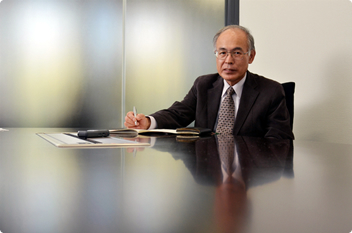Mathematical analysis possesses unlimited possibilities for application.
I started my career with physics.

What is mathematical analysis?
Mathematical analysis enables a range of phenomena in various fields to be analyzed by making use of mathematics and physics. At one time it was known as mathematical physics. Mathematics and physics both originated from philosophy and the academic boundary between the two was not clearly defined until the 19th century. Therefore, they have a synergistic effect on each other.
In which fields of business is mathematical analysis used?
To give a few examples, mathematical analysis is used in mathematical biology that deals with analysis of the food chain of a living being and genetics; mathematical economics that helps predict economic trends; and mathematical linguistics utilized for the development of automatic translation software. The "mathematical" fields of science seem to be growing. Mathematical analysis is also a good match with psychology. Today, its adaptation to the development of learning capacities for robots and in artificial intelligence is gaining a lot of attention.
Was mathematical physics your major at university?
I started to learn physics at university, where I studied nuclear physics. After I finished the graduate course, I worked as an assistant at a nuclear research facility for two years. Following that, I returned to the master's course at graduate school to study differential geometry for a further two years. During this time, intrigued by the science of mathematical analysis, I determined to establish myself as a mathematics and computer expert, at the age of 30./p>
I developed my interest in optics after I joined Nikon.
Why did you join Nikon Systems Inc.?
After completing studies at the graduate school, I was occupied with the job of radiation measurement for several years. But I had a desire to utilize the talents I'd acquired in wider fields beyond atomic science, so I joined Nikon Systems Inc., which dealt with the software built into a wide spectrum of advanced products, including IC steppers and scanners, and measurement equipment.
Tell us about your first job at Nikon.
My first job for the company was to analyze software designed to measure the surface finish in lens polishing, and prepare a report. This involved a gigantic lens intended for use with IC steppers and scanners. The mission of the software was to measure the concavity, convexity and undulation of the lens surface. The operation I faced had already been conducted for some time by many experts, and therefore, the final volume of data I had to deal with was huge. My assignment was to analyze this information and compile a report.
You were assigned a difficult task from the very beginning.
As I did not have much knowledge of optics, I was perplexed at first. I tried to hark back to what I had learned at school, and started to review what I had learned in the past. I read a variety of books, including Principles of Optics, coauthored by Max Born and Emil Wolf.
Did the image you had of optics change much?
My original image of optics was somewhat closer to that I had toward Euclidean geometry, very flat and two-dimensional. Once I had started learning optics, however, I found it was much closer to the differential geometry which I'd learned at graduate school. At that time, I began to develop a special interest in optics, which continue to intrigue me.
